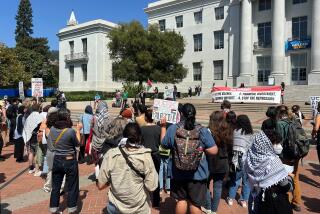Quake Repair Delay Frustrates Cal State L.A.
- Share via
A classroom shortage, disruption of student social life and a sense of frustration at the slow pace of repairs are continuing legacies at Cal State Los Angeles of last year’s earthquake, which caused $20.5-million worth of damage and one death at the campus.
Only about $3.2-million worth of repairs have been completed because of what officials describe as the complicated bureaucratic approvals needed to obtain the rest of the money from the state and federal governments. Administrators expect it will take another year for the school to return to normal but that the placement of portable classrooms will bring some relief later this month.
Most seriously damaged, Ruben Salazar Hall, the second largest classroom building, remains closed because of the earthquake and the resulting loosening of dangerous asbestos insulation. That has forced classes to be held in any available spaces, including clubrooms in the Student Union and a portion of the cafeteria, students and teachers complain.
“It puts a burden on us and our education,” said Student Body President Jimmy Granillo. “The integrity of our education goes down.”
Howard Holladay, the communications professor who is chairman of the faculty’s Academic Senate, explained: “We have suffered in relation to classes dislocated and put in less than desirable spaces. And that’s still continuing.”
Last February, the Academic Senate passed a resolution urging the Cal State system and state government to solve what Holladay called “the bureaucratic snafus” delaying the repairs at the campus in Lincoln Heights. School officials “could have been a little more aggressive” in pushing for the monies, although progress now seems likely, Holladay said.
‘A Long and Tedious Process’
Cal State administrators did not anticipate the amount of documentation and inspections required for funding by the state Office of Emergency Services and by the Federal Emergency Management Agency, according to Alex Carter, the campus vice president for operations. “In the first few days after the earthquake, with all the publicity and the feeling of pulling together, we expected things to move more quickly,” Carter said. “It has become a very long and tedious process.”
For example, he said, arguments over funding delayed the placement of 24 portable classrooms until, as is now expected, several weeks after the start of this fall quarter. On a campus parking lot, those temporary structures will replace about half the space lost by the closure of Salazar Hall and allow student clubs more use of the Union meeting rooms again.
“We’ve made a good adjustment to the consequences of the earthquake but we’re not at peace with how things are,” Carter said. He stressed that no classes have had to be canceled and all of the campus, except for Salazar Hall and parts of the University Library, is now safe.
Visitors find the earthquake did not diminish the vibrancy of the campus, which is attended by more than 19,000 students, many from the Eastside and San Gabriel Valley. Attendance figures show no discernible drop in enrollment.
However, Student Body President Granillo thinks some potential students probably decided to enroll elsewhere. “Wooden logs holding up a structure don’t give a very positive image,” he said, referring to the pillars propping up the three-story, and now closed, pedestrian bridge between the wings of the library.
There is still some unease because of such visible reminders of the Oct. 1 disaster, students say. Many plaster walls still show cracks. And new metal rods anchor the concrete slabs on a parking garage; during the quake, one of those slabs fell and crushed to death Lupe Elias-Exposito, a 21-year-old microbiology student.
“Sometimes, when I am on a second or third floor of a building, I start to wonder about the safety,” said Virginia Paniagua, a senior business administration student.
Evacuation Drill Set
Emergency communications systems have been improved recently and, beginning this quarter, all teachers are required to discuss with their classes evacuation procedures, according to Gerald Lipson, campus police chief. A campus-wide earthquake drill will be held later this fall, said Lipson, who added: “I have no worries about this university and safety matters.”
Meanwhile, the $5-million lawsuit filed by Elias-Exposito’s family against the state is still pending, according to their attorney, Lawrence Booth. Part of the suit seeks damages for the emotional distress suffered by Rosie Elias-Exposito, who witnessed her sister’s death. Rosie continued her studies at Cal State Los Angeles last year but recently decided to transfer, Booth said.
“Walking around that campus is tough for her,” the attorney explained. “She tried to do it for a year, but she just can’t do it anymore.”
A scholarship fund in Lupe’s honor now totals more than $8,000 and decisions on how to award the monies will be made by the end of the school year, said Agi Lontai, a microbiology lab supervisor who is on the scholarship committee.
More to Read
Sign up for Essential California
The most important California stories and recommendations in your inbox every morning.
You may occasionally receive promotional content from the Los Angeles Times.














